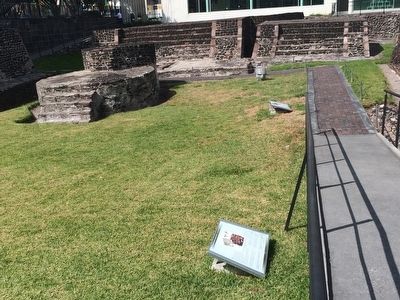Colonia Tlatelolco in Ciudad de México, Mexico — The Valley of Mexico (The Central Highlands)
Tzompantli altar (“flag of heads”) of the south.
Altar Tzompantli (“bandera de cabezas”) del sur
Inscription.
A través del tiempo y en distintos lugares del mundo, ha existido la práctica de exhibir las cabezas de los enemigos como trofeos de guerra. Uno de los pueblos mesoamericanos que más lo hicieron, fueron los mexicas, quienes de acuerdo a las fuentes históricas y arqueológicas, se sabe que acostumbraban exhibir las cabezas de sus adversarios sacrificados, las cuales eran ensartadas en travesaños mediante un agujero que se hacía en las parietales (ambos lados del cráneo).
Durante las exploraciones arqueológicas de 1965 se localizó un conjunto de cráneos humanos perforados por los parietales junto a un Ehecacózcatl (gran caracol cortado) símbolo del Dios Quetzalcóatl.
En Tlatelolco existen dos de estos altares: el Tzompantli del norte y éste, el Tzompantli del Sur.
Pie de dibujos:
Tzompantli del Códice Tovar.
Ejemplo de perforación en cráneo.
Foto: Eduardo Contreras G.
Throughout time and in different parts of the world the practice of exhibiting the heads of enemies as war trophies has existed. One of the many Mesoamerican peoples that mostly did this was the Mexicas, who according to historic and archeologic sources, used to exhibit the heads of their sacrificed enemies. They inserted their heads in a crossbar by making holes on opposite sides of the skulls.
During the archeologic explorations of 1965 a set of skulls were found, all of them with the parietal bones perforated. These were found beside an Ehecacózcatl (large sea shell with a transverse cut) symbol of Quetzalcóatl the god.
In Tlatelolco there are two of these altars: the north Tzompantli and this, the south Tzompantli.
English translation of captions:
Tzompantli from the Tovar Codex.
An example of the perforation of a skull.
Photo: Eduardo Contreras G.
Topics. This historical marker is listed in these topic lists: Anthropology & Archaeology • Man-Made Features • Wars, Non-US. A significant historical year for this entry is 1965.
Location. 19° 27.044′ N, 99° 8.265′ W. Marker is in Ciudad de México. It is in Colonia Tlatelolco. The marker is at the Tlatelolco Archeological Site on Eje Central near the intersection with Avenida Ricardo Flores Magón. Touch for map. Marker is in this post office area: Ciudad de México 06900, Mexico. Touch for directions.
Other nearby markers. At least 8 other markers are within walking distance of this marker. Superimposed altars (here, next to this marker); The Tlatelolco Lovers (a few steps from this marker); The Palace (a few steps from this marker);
The Calendar Temple (a few steps from this marker); Ehécatl Quetzalcóatl: attracting rain and fertility (a few steps from this marker); Tlatelolco: a well-planned city (within shouting distance of this marker); The Southern Plaza of the Sanctuary (within shouting distance of this marker); Tlatelolco’s great temple (“Templo Mayor”): A mirrored image of Tenochtitlan (within shouting distance of this marker). Touch for a list and map of all markers in Ciudad de México.
Credits. This page was last revised on April 17, 2020. It was originally submitted on January 4, 2016, by J. Makali Bruton of Accra, Ghana. This page has been viewed 299 times since then and 12 times this year. Photos: 1, 2. submitted on January 4, 2016, by J. Makali Bruton of Accra, Ghana.

